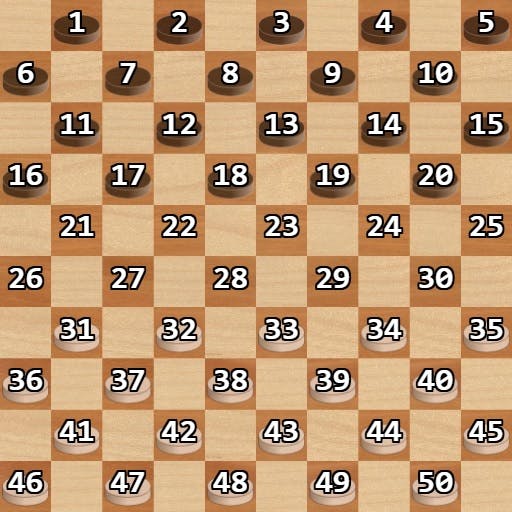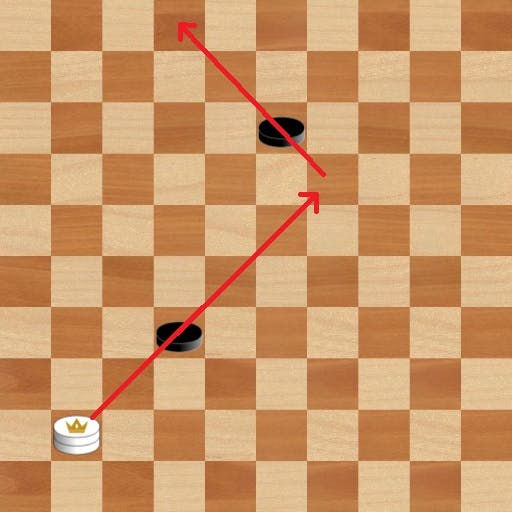International
Standard rules of international draughts (FMJD)
The board
International draughts is played on a 10x10 board.
Only the dark squares of the board are used. Both players (black and white) start with 20 pieces or men, placed on opposite sides of the board.

The coordinate system traditionally used in draughts is quite different from the algebraic notation used in chess. Only the dark squares of the board are used, there are 50 fields that the pieces can occupy on a 10x10 board. The fields are numbered 1-50 accordingly, where field 1 is top left from the white perspective, counting towards field 50 on the bottom right.

Moves and captures
The white player always starts the game, after which turns are alternate.
Ordinary pieces or men always move one square diagonally forwards, to an unoccupied square.

Capturing is done by jumping over an enemy piece, two squares forwards or backwards, to an unoccupied square immediately beyond it.

Capturing is always forced, so when a player can capture, they must capture.
If a piece can capture again from the square where it lands, it must continue capturing. This way it can make multiple successive jumps, and thus capture multiple enemy pieces in one turn. It is not allowed to jump over the same piece more than once.

If multiple paths are available, the player is always forced to play the longest capture sequence possible.
It is important to note that the enemy pieces are only removed from the board after the whole capture sequence has been completed. Not following this rule could create illegal capturing possibilities, as can be seen from the solution to this puzzle after some careful observation.
The king
If a piece ends its turn on a square at the other edge of the board, it is crowned and turns into a king. This is only possible at the end of the turn, so nothing happens when a piece reaches the edge during a capture sequence.
A king has the advantage that a player can move it as many squares as they want, both forwards and backwards. It can also land as many squares as it wants behind a piece it captures, which creates a lot of extra possibilities (although it still has to capture the maximum number of pieces possible).

Winning and drawing
- A player wins the game when the opponent no longer has any valid moves. This can be either because all of the player's pieces have been captured, or because they are all blocked and thus have no more squares available to move to.
- If the same position appears on the board for the third time, with the same side to move, the game is considered drawn by threefold repetition.
- The game is drawn when both players make 25 consecutive king moves without capturing.
- When one player has only a king left, and the other player three pieces including at least one king (three kings, two kings and a man, or one king and two men), the game is drawn after both players have made 16 moves.
- When one player has only a king left, and the other player two pieces or less including at least one king (one king, two kings, or one king and a man), the game is drawn after both players have made 5 moves.